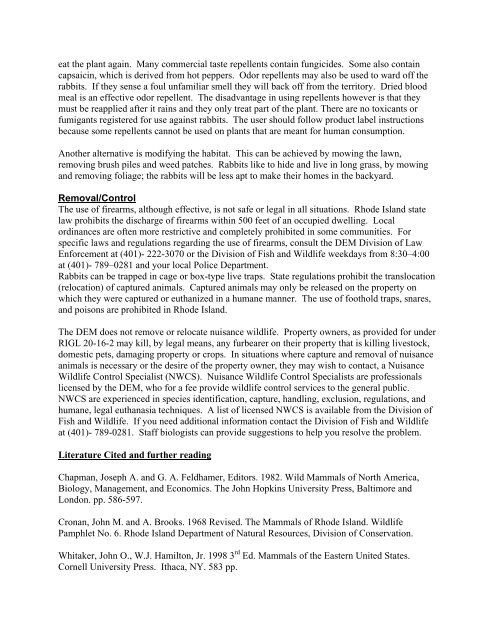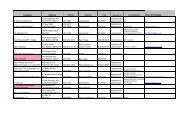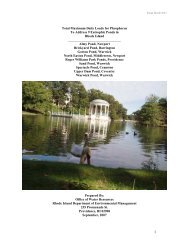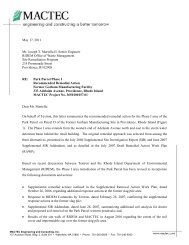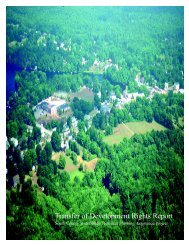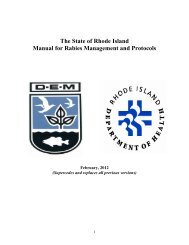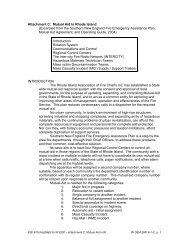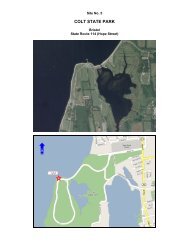Cottontail Rabbits in Rhode Island - Rhode Island Department of ...
Cottontail Rabbits in Rhode Island - Rhode Island Department of ...
Cottontail Rabbits in Rhode Island - Rhode Island Department of ...
Create successful ePaper yourself
Turn your PDF publications into a flip-book with our unique Google optimized e-Paper software.
eat the plant aga<strong>in</strong>. Many commercial taste repellents conta<strong>in</strong> fungicides. Some also conta<strong>in</strong><br />
capsaic<strong>in</strong>, which is derived from hot peppers. Odor repellents may also be used to ward <strong>of</strong>f the<br />
rabbits. If they sense a foul unfamiliar smell they will back <strong>of</strong>f from the territory. Dried blood<br />
meal is an effective odor repellent. The disadvantage <strong>in</strong> us<strong>in</strong>g repellents however is that they<br />
must be reapplied after it ra<strong>in</strong>s and they only treat part <strong>of</strong> the plant. There are no toxicants or<br />
fumigants registered for use aga<strong>in</strong>st rabbits. The user should follow product label <strong>in</strong>structions<br />
because some repellents cannot be used on plants that are meant for human consumption.<br />
Another alternative is modify<strong>in</strong>g the habitat. This can be achieved by mow<strong>in</strong>g the lawn,<br />
remov<strong>in</strong>g brush piles and weed patches. <strong>Rabbits</strong> like to hide and live <strong>in</strong> long grass, by mow<strong>in</strong>g<br />
and remov<strong>in</strong>g foliage; the rabbits will be less apt to make their homes <strong>in</strong> the backyard.<br />
Removal/Control<br />
The use <strong>of</strong> firearms, although effective, is not safe or legal <strong>in</strong> all situations. <strong>Rhode</strong> <strong>Island</strong> state<br />
law prohibits the discharge <strong>of</strong> firearms with<strong>in</strong> 500 feet <strong>of</strong> an occupied dwell<strong>in</strong>g. Local<br />
ord<strong>in</strong>ances are <strong>of</strong>ten more restrictive and completely prohibited <strong>in</strong> some communities. For<br />
specific laws and regulations regard<strong>in</strong>g the use <strong>of</strong> firearms, consult the DEM Division <strong>of</strong> Law<br />
Enforcement at (401)- 222-3070 or the Division <strong>of</strong> Fish and Wildlife weekdays from 8:30–4:00<br />
at (401)- 789–0281 and your local Police <strong>Department</strong>.<br />
<strong>Rabbits</strong> can be trapped <strong>in</strong> cage or box-type live traps. State regulations prohibit the translocation<br />
(relocation) <strong>of</strong> captured animals. Captured animals may only be released on the property on<br />
which they were captured or euthanized <strong>in</strong> a humane manner. The use <strong>of</strong> foothold traps, snares,<br />
and poisons are prohibited <strong>in</strong> <strong>Rhode</strong> <strong>Island</strong>.<br />
The DEM does not remove or relocate nuisance wildlife. Property owners, as provided for under<br />
RIGL 20-16-2 may kill, by legal means, any furbearer on their property that is kill<strong>in</strong>g livestock,<br />
domestic pets, damag<strong>in</strong>g property or crops. In situations where capture and removal <strong>of</strong> nuisance<br />
animals is necessary or the desire <strong>of</strong> the property owner, they may wish to contact, a Nuisance<br />
Wildlife Control Specialist (NWCS). Nuisance Wildlife Control Specialists are pr<strong>of</strong>essionals<br />
licensed by the DEM, who for a fee provide wildlife control services to the general public.<br />
NWCS are experienced <strong>in</strong> species identification, capture, handl<strong>in</strong>g, exclusion, regulations, and<br />
humane, legal euthanasia techniques. A list <strong>of</strong> licensed NWCS is available from the Division <strong>of</strong><br />
Fish and Wildlife. If you need additional <strong>in</strong>formation contact the Division <strong>of</strong> Fish and Wildlife<br />
at (401)- 789-0281. Staff biologists can provide suggestions to help you resolve the problem.<br />
Literature Cited and further read<strong>in</strong>g<br />
Chapman, Joseph A. and G. A. Feldhamer, Editors. 1982. Wild Mammals <strong>of</strong> North America,<br />
Biology, Management, and Economics. The John Hopk<strong>in</strong>s University Press, Baltimore and<br />
London. pp. 586-597.<br />
Cronan, John M. and A. Brooks. 1968 Revised. The Mammals <strong>of</strong> <strong>Rhode</strong> <strong>Island</strong>. Wildlife<br />
Pamphlet No. 6. <strong>Rhode</strong> <strong>Island</strong> <strong>Department</strong> <strong>of</strong> Natural Resources, Division <strong>of</strong> Conservation.<br />
Whitaker, John O., W.J. Hamilton, Jr. 1998 3 rd Ed. Mammals <strong>of</strong> the Eastern United States.<br />
Cornell University Press. Ithaca, NY. 583 pp.


